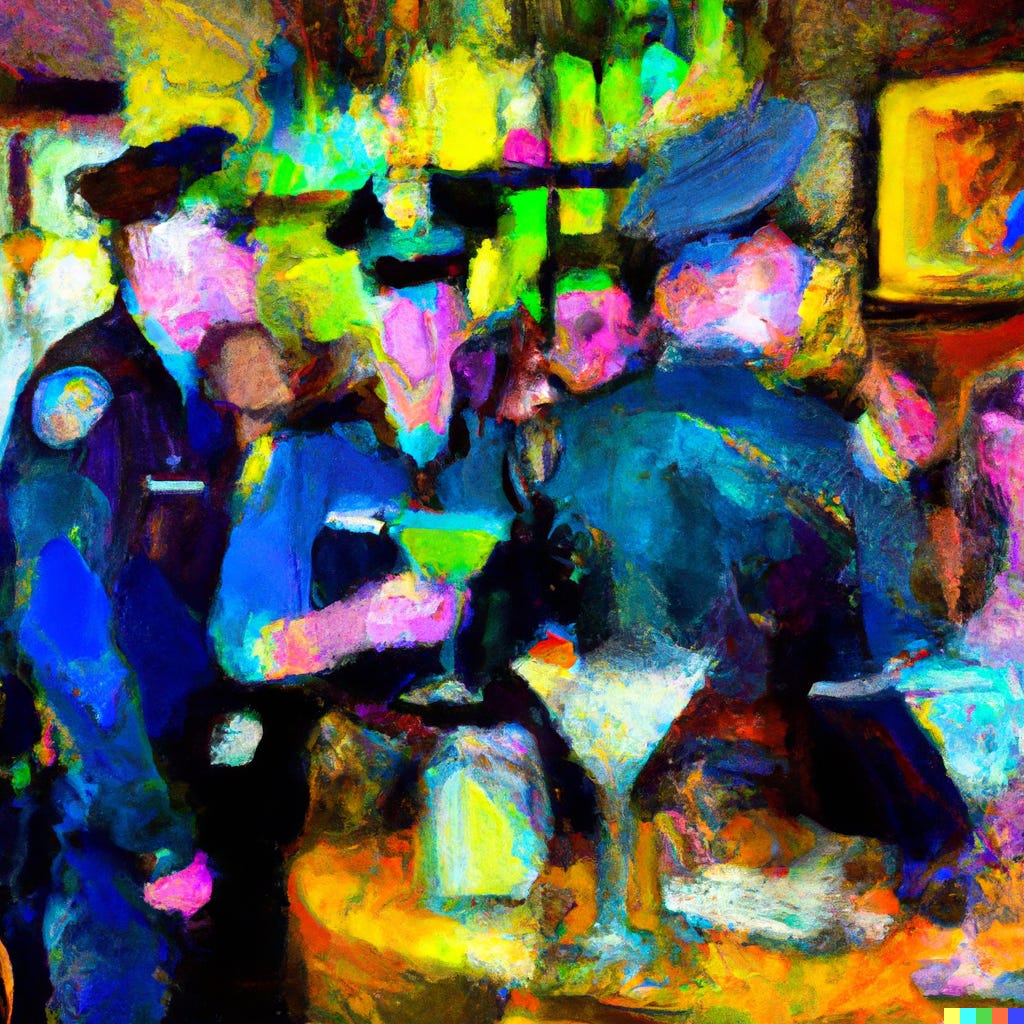Dear readers and listeners,
We are back with Peter Suderman’s semi-annual visit to the Very Serious podcast! Getting ready for spring, Peter and I talked about best practices for muddling fresh fruit into cocktails. We talked about Peter’s philosophy of the 41-bottle bar, about his favorite non-alcoholic cocktails, and about why he has no use for vodka. Sara even got in a question about how to improve a cocktail she felt had a design flaw.
We also talked about “x-tini” cocktails — relics of the bad old days (the 1980s and the 1990s) when bars would mix together any brightly colored fruit liqueur with spirits and sour mix and who knows what else and call the drink some kind of “-tini.” But we also talked about a silver lining of that age — the espresso martini, birthed then and once again popular today, which Peter has methods for improving (think gin or mezcal).
In fact, Peter is even making appletinis now — but with fresh Granny Smith apples instead of DeKuyper Sour Apple Pucker. If you subscribe to his newsletter, you’ll get an issue later today with the recipe he developed.

I want to thank those of you who sent in cocktail questions, some of which we used in the episode. I also want to use today’s newsletter to address one we didn’t get to. Mark wrote in:
You have (correctly) commented that many restaurants serve badly oversized martinis, the consequences of which size are that the drink either gets warm or — to enjoy cold — must be consumed too quickly.
This past weekend, at Ci Siamo, I had the house martini. It was served with only ⅔ of the drink in the martini glass, and the balance provided separately in a small glass vial nestled in a glass of crushed ice, along with assorted accoutrements. All in all, a nice presentation, and one I had not previously encountered. Have either of you seen this and, either way, what do you think?
I have talked a bunch about martini inflation, mostly on Twitter, and I think Alex Godofsky has a plausible theory: Over the decades, as labor has increased in price relative to liquor, it’s made sense for restaurants and bars to produce larger cocktails.
That is: A restaurant serving big-ass cocktails will go through more liquor than (and probably can’t charge as much per fluid ounce as) one that sells reasonably sized cocktails. But the price per cocktail can be higher with big-ass than regular, and if you sell a smaller number of bigger, more expensive drinks, you reduce the amount of labor you need from bartenders and waitstaff. Basically, it’s Baumol’s cost disease: Bartending is labor-intensive, and bartenders haven’t had major improvements over the decades in the speed with which they can make a drink, so as overall wage levels grew, there was pressure to cut down on the amount of personal service associated with the sale of a martini. The way to do that was to make the martini bigger — a martini so big it’s a three-martini lunch in a single glass, and that the bartender only has to stir once.
Anyway, that’s one theory. Another more simple theory is that everything has gotten bigger as we’ve gotten richer and fatter and people just like huge cocktails.
As Mark points out, gluttony and hangovers aren’t the only problem with martinis as big as your head. The biggest problem with an 11-ounce martini is that martinis are supposed to be ice cold, and there’s no non-disgusting way to drink that much martini before it’s gotten warm. My preferred solution to this — the one I use at home — is to serve small, dignified cocktails. But the form of service Mark describes, with part of the drink held in reserve on ice, is another solution.
I have seen a variation on this presentation actually right around the corner from Ci Siamo, at Chez Zou, the upstairs lounge at Zou Zou’s. All three of these establishments are located in the Manhattan West development across 10th Avenue from Hudson Yards, and all three are worth your time.1
Sara: In Los Angeles, this is how the excellent bartenders at Musso & Frank Grill serve martinis and it is perfect. One other acceptable alternative is at the Hillstone Restaurant Group properties (Hillstone, Houston’s, Bandera, Honor Bar, etc.). There, your server or bartender will — without you even needing to ask — pour your half-full-but-no-longer-ice-cold martini into a freshly chilled glass.
I've also seen a less-refined version of this idea, which is to bring the martini to the table in a tiny cocktail shaker, where the server pours part of the drink into the glass, leaving the rest in the shaker to be poured later. The problem with this approach, of course, is that ice keeps melting into your drink, so it's not as good as the tiny decanter on ice, though it's probably also not as complicated for the service staff.
In any case, I endorse the Ci Siamo style of martini service, though you should really remember that what you’re getting in this format is probably closer to two regulation-size martinis than one.
Very seriously,
Josh
Episode links and references
Click here for a transcript of this episode.
Here’s Peter Suderman’s Substack:
We referenced these articles Peter wrote:
Peter’s revamp of the appletini will be published Friday afternoon.
Podcasts
If you missed the first two times Peter came on the Very Serious podcast, catch up here. There’s a lot of useful information from the fall episode, and a lot of useful and timely information from last spring’s episode — including tips for batching cocktails for your guests before they arrive. Many of you submitted questions for Peter on that topic.
Books
Raising The Bar, by Brett Adams and Jacob Grier
Apéritif, by Rebekah Peppler
Bottles and cocktails
Chartreuse scarcity, as reported in the New York Times; a trend piece on the resurgence of the Appletini from the fall (both unlocked articles, no NYT subscription required)
Seedlip nonalcoholic spirits
The Phony Negroni from St. Agrestis
Dirty Lemon Tonic (nonalcoholic) by Rebekah Peppler (unlocked NYT recipe)
I can vouch for Chez Zou and Zou Zou’s, the latter of which I’ve written about previously. I haven’t made it to Ci Siamo yet, but my husband had lunch there and said it’s very good, albeit a bit heavy for lunch since it’s northern Italian. Of course, if you go at dinner, you’ll be ready for a bigger meal and you’ll be able to have a martini.













